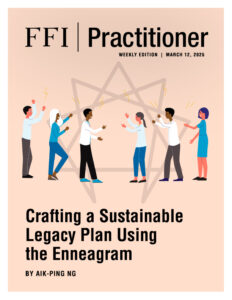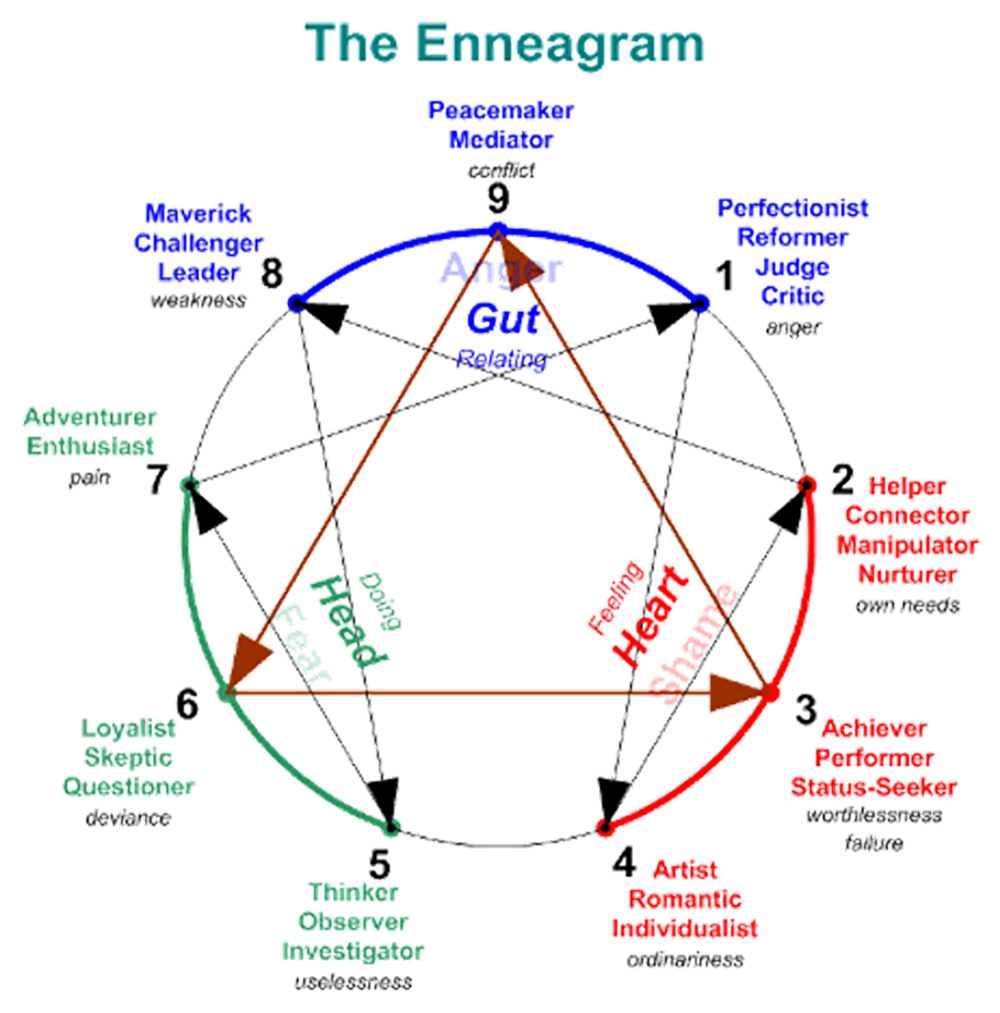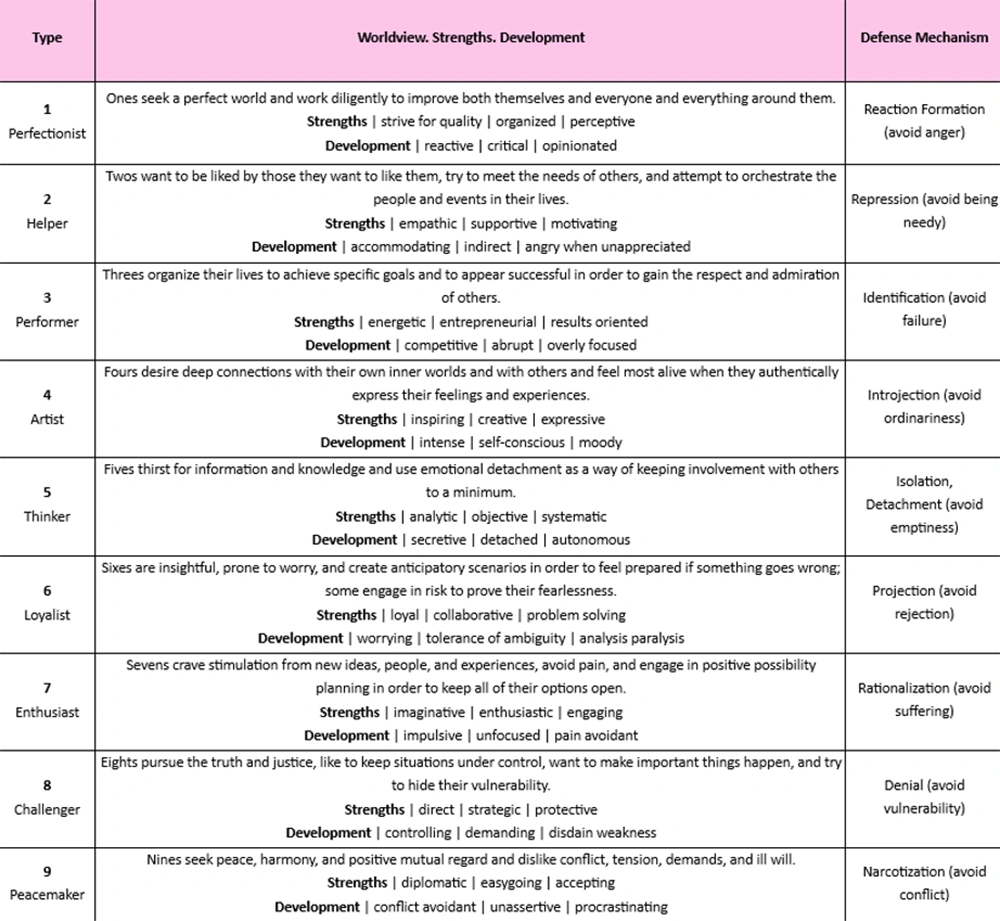
View this edition in our enhanced digital edition format with supporting visual insight and information.
In this week’s FFI Practitioner, FFI Asian Circle Virtual Study Group member Aik-Ping Ng discusses how family enterprise advisors can use the Enneagram, a personality assessment tool, to help guide their clients through conflict and improve communication. Aik-Ping introduces the Enneagram’s nine personality types and explores their utility through a case study, demonstrating the ways in which assessing clients’ types and growth directions can help advisors mitigate family conflict and develop action plans for improvement.
I have always been intrigued by the art and science of personality profiling. An engineer by training who never did a day of engineering work, I studied psychology as a minor in college under the late psychologist Philip Zimbardo, the man behind the Stanford Prison Experiment.
Over many years in corporate life, I have come across many types of personality profiling tools, including MBTI, DISC, 16PF, and BFI. I chanced upon the Enneagram while taking a course a few years ago with my wife. I found the Enneagram very precise at describing how individuals for each Enneagram type think, feel, and react, but the system’s power comes from its explanations of individuals’ underlying motivations and suggestions for growth. Understanding the Enneagram can be helpful for family business advisors who want to dig deep into the individual and collective personalities of the families they serve and make a deep, lasting impact.
What is the Enneagram?
The word “enneagram” comes from the Greek words ennea (“nine”) and gramma (“something drawn or written”), referring to the nine points on the Enneagram symbol. While the history of the Enneagram is uncertain, this personality profiling system first appeared in both Asia and the Middle East several thousand years ago (The Enneagram in Business 2025).

(Lacroix 2021)
The lines and arrows in the diagram represent the Direction of Growth and Direction of Stress for the different types, suggesting how each type may behave under stressful scenarios.

(The Enneagram in Business 2025)
How Does the Enneagram Apply to Family Business Consulting?
The Enneagram is a powerful tool that can help advisors understand family members’ motivations, core beliefs, and unconscious behavior. Everyone exhibits qualities of all nine types, although each individual has a dominant type.
Understanding each family member’s Enneagram allows advisors to work toward a variety of goals, including the following:
- Improve and Tailor Communication Styles
Tailoring communication styles can help advisors resonate more with individuals. For example, a Type 5 (Thinker) appreciates data-driven discussions, while a Type 4 (Artist/Individualist) may need additional time and space to share his or her unique perspective. A Type 8 (Challenger) requires direct feedback without beating around the bush. - Identify Conflict Triggers and Mediation Strategies
Each Enneagram type has its own motivations and fears. By acknowledging these, advisors are better prepared to identify potential conflict triggers and design suitable mechanisms for conflict resolution. For example, a Type 6 (Loyalist) may fear instability, while a Type 9 (Peacemaker) may avoid confrontation and need to be encouraged to share their views on the conflict. - Identify and Prepare Candidates for Family Enterprise Roles
Understanding Enneagram can help identify potential leaders within the family system for specific roles in alignment with the family member’s strengths. For example, while a Type 3 (Performer) or a Type 8 (Challenger) may appear to be the natural choice as CEO of the family business, a Type 7 (Enthusiast) may be the entrepreneur looking for the family’s next business or growth opportunity.
Case Study*
The Zhou family owns and operates a successful farming business in Asia. The patriarch, Mr. Zhou, is warm-hearted, unrestrained, and forthright, and likes to be bold and strategic (Type 8: Challenger). A serial entrepreneur from a young age, Mr. Zhou took control of the business after the sudden departure of his two business partners. Many of his relatives hold key positions in the company, the most senior of which was his sister, Ms. Zhou, the CFO. Ms. Zhou, single, is highly organized and quality-driven, but has difficulty relaxing at work, and can be reactive and over-critical (Type 1: Perfectionist).
Mr. Zhou’s two children, Anthony and Zoe, are two years apart in age and work in the business. Anthony is energetic and results-oriented, but competitive and focused on expanding the business (Type 3: Performer). Zoe is introspective and expressive, with strong views about wanting the business to be unique and authentic (Type 4: Artist/Individualist).
As the family began to plan for the eventual succession within the business, it faced conflict regarding the business’s future direction. Anthony sought rapid growth with his Type 3 belief that the world values winners and ridicules losers. Zoe, however, believed authenticity and family heritage should not be compromised in pursuit of growth. Mr. Zhou was concerned that his children’s differing views could threaten the business’s future. He wanted to keep the situation under control but found it difficult to express his vulnerability.
With Mr. Zhou championing family change, each family member’s Enneagram type was identified through individual assessments, which provided insights into each person’s underlying motivations. In addition to the self-reported individual assessments, each family member answered type-confiming questions.
A family meeting was organized where each member shared what the family legacy meant to them. The advisor guided the family to address underlying conflicts by first acknowledging each member’s core beliefs, emotional patterns, and behaviors.
Mr. Zhou learned to appreciate that Anthony’s ambitious growth plans were based on his desire to honor the family entrepreneurial legacy. Zoe also recognized that she could better contribute to the family business by preserving the family’s cultural heritage. Anthony began to see value in his sister’s deep introspection to enhance the brand’s authenticity.
With this new understanding, the family collaborated to set family-oriented objectives, including balancing the pursuit of growth for the business while maintaining traditional operational practices, continuing to invest in core systems and policies to uphold strong corporate governance standards, and involving the next generation in key decision-making to ensure continuity and good stewardship.
Developmental plans were also designed for each member to challenge common assumptions and increase self-mastery:
Mr. Zhou: Patriarch (Type 8: Challenger)
- To help deepen relationships with his children, Mr. Zhou was encouraged to bring out his nurturing and softer side and to be more open with his vulnerabilities and fears (Growth Direction towards Type 2: Helper).
Action: Schedule a monthly lunch appointment with each child for quality time and to catch up without talk about work. - Tame anger with objectivity and consideration before acting (Growth Direction towards Type 5: Thinker)
Action: When the body is tense, do a breathing exercise to relax. Think twice before acting.
Ms. Zhou: Patriarch’s sister (Type 1: Perfectionist)
- Ms. Zhou was encouraged to look at the positive side of things rather than at what was wrong with the business or others (Growth Direction towards Type 7: Enthusiast).
Action: Engage in a gratitude journal exercise and reflect on three good things daily. - Improve communication and pay attention to self “right/wrong” language (Growth Direction towards Type 4: Artist/Individualist).
Action: Notice when words that imply judgement are used, e.g., “should,” “ought,” “correct,” “mistake,” and “error.” Use language that encourages sharing of alternative viewpoints.
Anthony: Son (Type 3: Performer)
- Anthony was encouraged to practice active listening to connect more deeply with others and learn to see things from others’ perspectives (Growth Direction towards Type 9: Peacemaker).
Action: Slow down to allow others to express themselves fully. Engage in a chosen mindfulness activity monthly. - Learn humility and ignite inspiration in others to help them succeed. Seek feedback from the team and find meaning in winning together rather than winning for winning’s sake (Growth Direction towards Type 6: Loyalist).
Action: Spend time with people not normally perceived as “successful” and discover their strengths.
Zoe: Daughter (Type 4: Artist/Individualist)
- Zoe was encouraged to become less negative and aspire towards emotional level-headedness (Growth Direction towards Type 1: Perfectionist).
Action: Journal using Feelings Wheel (Roberts 2015) to make sense of emotions and gain clarity and objectivity over stressful situations. - Become more attuned to the needs of others (Growth Direction towards Type 2: Helper).
Action: In a conversation, pause and listen carefully to the other party to ascertain their needs.
With both the personal development plans and the family’s collective development plan in place, quarterly follow-up meetings were arranged with each family member to ascertain progress of individual objectives. The collective Enneagram development growth plan for the family was also added into the annual family meeting’s agenda with Mr. Zhou himself as the champion for driving change. Over time each family member was able to move towards their respective Direction of Growth, though at their own pace and unique path.
Tips for Advisors
Advisors can offer insights and guidance using Enneagram techniques to support families navigating the challenges of intergenerational relationships. Here are some practical tips for those new to the Enneagram:
- Understand the Tools and Available Enneagram Resources
Advisors can familiarize themselves with each Enneagram type’s key personality traits, including motivations, fears, and core beliefs. Reputable Enneagram assessments such as the RHETI (Riso-Hudson Enneagram Type Indicator) ensure accurate typing. After each family member’s type is assessed, advisors could hold both one-on-one discussions to explore the results using personal reflection worksheets, as well as collective family conversations so that the family understands the Enneagram’s purpose and benefits. Advisors can bring in experienced Enneagram facilitators or coaches during this process. - Facilitate Open Dialogue
Advisors benefit from creating open, safe spaces for family members to share how their types influence communication and conflict resolution styles. Advisors can also help focus the discussions on examining each family member’s attitudes and values, and they can assist family members in considering how their types might influence their visions for the future. - Set Personal Growth Targets for Individual Family Members
It is important that advisors follow through with the developmental activities with each family member; this can foster a positive change mindset based on the family’s common purpose. Advisors can base collective goal setting on a spirit of inclusivity. - Be Patient and Flexible
It is best for family members to be given space to grow using the Enneagram’s insights. Advisors could use this process to foster clients’ self-awareness and accountability.
* All client identifying data in the cases have been removed. Names and facts are masked and any similarity or resemblance to any person, is purely coincidental.
References
Lacroix, Fred. “The Enneagram FAQ.” Effective September 23, 2021. https://aprisme.blog/en/non-classe-en/the-enneagram-faq/
Lapid-Bogda, Ginger. Bringing Out the Best in Everyone You Coach: Use the Enneagram System for Exceptional Results. McGraw Hill, 2009.
Roberts, Geoffrey. “Emotional Word Wheel.” Effective March 5, 2015. https://imgur.com/i-feel-emotional-word-wheel-feel-wheel-australian-english-tCWChf6. Quoted in https://feelingswheel.com/.
The Enneagram in Business. “The Enneagram in Business.” Accessed February 12, 2025. https://theenneagraminbusiness.com/about-the-enneagram/the-9-enneagram-type-descriptions/
About the Contributor

Aik-Ping Ng, CFBA/CFWA, is managing director and head of Family Office Advisory Asia Pacific at HSBC Global Private Banking. With twenty-two years of experience in private equity, corporate finance, and wealth management, he advises UHNW families on legacy planning. He can be reached at aikping.ng@gmail.com.

View this edition in our enhanced digital edition format with supporting visual insight and information.





